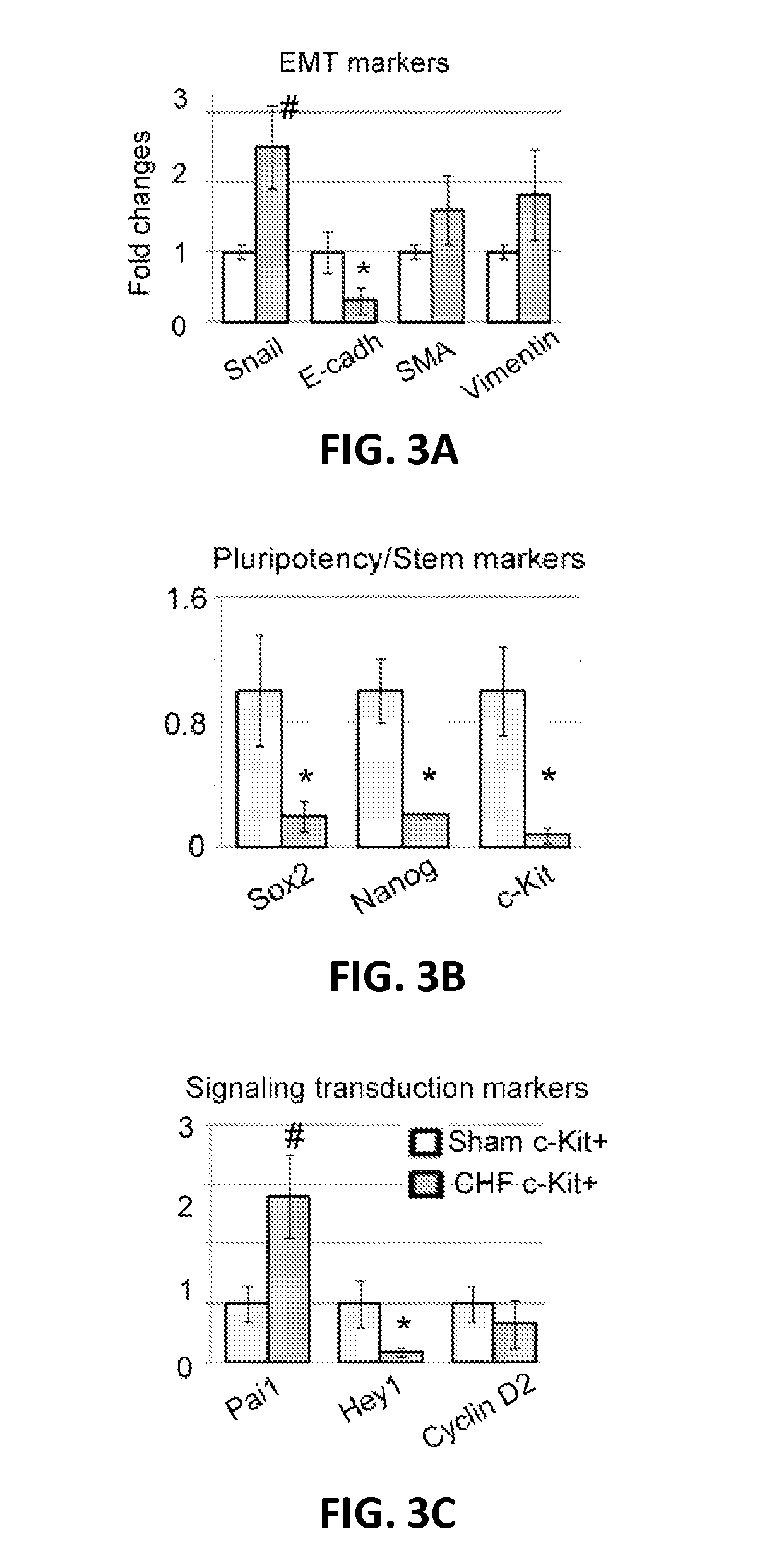Stem cell compositions and methods of their use
a technology of stem cells and compositions, applied in the field of stem cell compositions and methods of their use, can solve the problems of not faithfully recapitulating disease processes, relatively expensive and time-consuming generation of ips cells, and inability to accurately recapitulate disease processes
- Summary
- Abstract
- Description
- Claims
- Application Information
AI Technical Summary
Benefits of technology
Problems solved by technology
Method used
Image
Examples
example 1
Isolation and Characterization of Cardiac Stem Cells from Rats with Chronic Heart Failure
[0085]Cardiac stem cells were isolated from rats that had developed chronic heart failure (CHF) six weeks after myocardial infarction as follows. Two-month-old Sprague Dawley rats (Harlan Laboratories) were anesthetized and ventilated. Following a left thoracotomy, the heart was expressed, and the left anterior descending coronary artery was ligated using a 5-0 TiCron suture. The lungs were briefly hyperinflated, the chest was closed using 2-0 silk, and the rodents were allowed to recover with a pain management regiment of buprenorphine. Sham-operated animals underwent the same surgical procedure excluding left anterior descending artery occlusion.
[0086]Hemodynamic statistics were collected from the rats six weeks post-MI using a pressure-volume catheter (Millar Instruments) inserted into the right carotid artery and advanced into the left ventricle. The animals were systemically anesthetized wi...
example 2
TGF-β Inhibition Increased Pluripotency Markers in Cardiac Stem Cells
[0099]To determine the effect of inhibition of TGF-β signaling in cardiac stem cells on markers of epithelial / endothelial to mesenchymal transition (i.e., EMT markers) and pluripotency markers the following experiments were performed. Cardiac stem cells were isolated from sham and CHF heart tissue as described in Example 1 above. Cardiac stem cells from CHF and sham animals were treated in culture with TGF-β inhibitors SB431542 or SIS3 for 7 days and subsequently assessed for EMT and pluripotency expression by RNA expression analysis and western blotting using the techniques described above in Example 1.
[0100]As shown in FIGS. 4A and 4B, in sham cardiac stem cells, both SB431542 and SIS3 reduced SMA gene expression 2- and 5-fold, respectively, whereas in CHF cardiac stem cells, SMA reduction was >10-fold for both inhibitors. Also, SB431542 upregulated E-cadherin expression by 6.2- and 3.6-fold in sham and CHF cardi...
example 3
TGF-β Inhibition Increased Differentiation Potential of Cardiac Stem Cells
[0102]The effects of TGF-β inhibition on the differentiation potential of cardiac stem cells was examined as follows. Cardiac stem cells were isolated from heart tissue of CHF and sham animals as described in Example 1 above. Cells were subsequently cultured in cardiac differentiation medium (EMD Millipore) supplemented with 2 μmol / L Mocetinostat (SelleckChem) in the presence or absence of TGF-β inhibitors SB431542 and SIS3 for 7 days. Expression of cardiac troponin T (TnT) was evaluated by immunocytochemistry. TnT is an accepted marker for cardiac differentiation. Cells were fixed / permeabilized with a 1:1 acetone:ethanol mixture, blocked with 3% BSA in PBS, and labeled with mouse anti-TnT primary antibody (Abcam). Specific staining was visualized using anti-mouse secondary antibodies conjugated with Alexa 568 (Molecular Probes). Nuclei were stained with 4′,6-diamidino-2-phenylindole (Invitrogen). TnT-positive...
PUM
| Property | Measurement | Unit |
|---|---|---|
| Composition | aaaaa | aaaaa |
Abstract
Description
Claims
Application Information
 Login to View More
Login to View More - R&D
- Intellectual Property
- Life Sciences
- Materials
- Tech Scout
- Unparalleled Data Quality
- Higher Quality Content
- 60% Fewer Hallucinations
Browse by: Latest US Patents, China's latest patents, Technical Efficacy Thesaurus, Application Domain, Technology Topic, Popular Technical Reports.
© 2025 PatSnap. All rights reserved.Legal|Privacy policy|Modern Slavery Act Transparency Statement|Sitemap|About US| Contact US: help@patsnap.com



